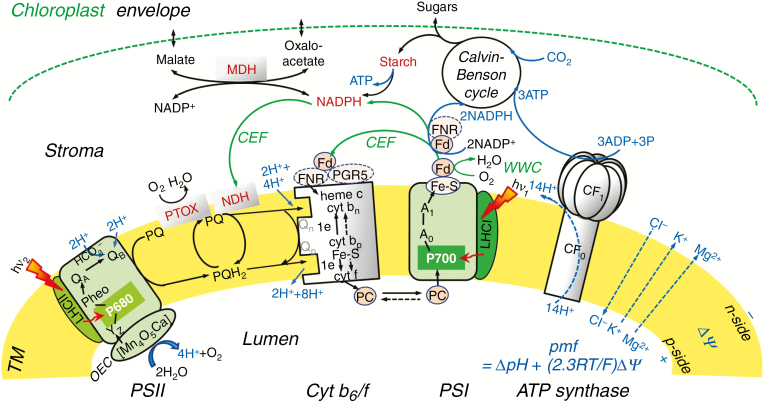Fig. 1.
Diagram of the photosynthetic apparatus and electron transport (ET) pathways in plants and algae. Four major protein complexes in the thylakoid membrane (TM) participate in the production of ATP and nicotinamide adenine dinucleotide phosphate in reduced form (NADPH), needed for the Calvin–Benson cycle to fix CO2 to produce sugars: two photosystems (PSII and PSI) connected in series via the cytochrome (Cyt) b6/f, and the ATP synthase. Light is absorbed simultaneously by pigments in the light harvesting complexes of PSI and PSII (LHCI and LHCII); excitation energy is transferred to reaction centre (RC) P700 (in PSI) and P680 (in PSII), where primary charge separation takes place, initiating a chain of redox reactions. PSII functions as a water/PQ (photo)-oxidoreductase, which has a manganese complex [Mn4O5Ca], and a tyrosine-161 (YZ), located on D1 protein on the electron donor side, as well as pheophytin (Pheo), plastoquinones QA and QB, and a non-haem (heme) iron binding a bicarbonate ion (HCO3‒) on the electron acceptor side. By contrast, PSI is a plastocyanin (PC)/ferredoxin (Fd) (photo)-oxidoreductase; it uses reduced PC as an electron donor, and a particular Chl a molecule (A0), vitamin K1 (A1), and three non-haem iron–sulfur centres (shown in the figure as Fe-S) are on the acceptor side of PSI. The Cyt b6/f complex includes a Cyt f, a Rieske iron–sulfur protein (Fe-S), two cytochromes b (Cyt bp and Cyt bn) that participate in the oxidation and reduction of PQH2 and PQ: PQH2 is oxidized at the Qp-site by Cyt bp, while PQ is reduced at the Qn-site by Cyt bn. The Qp- and Qn-sides are also called Qo- and Qi-sides, respectively. Besides the linear ET flow from water to NADP+, there are several pathways leading to electron donation to alternative electron acceptors: cyclic electron flow (CEF) around PSI mediated by Fd (involving Fd-NADP+-reductase, FNR, and a proton gradient regulator, PGR5), or NADPH (via NADPH dehydrogenase, NDH); water–water cycle (WWC); chlororespiration (through the plastid terminal oxidase, PTOX); and the malate valve (through malate dehydrogenase, MDH). The proton motive force (pmf) [consisting of the proton concentration difference (ΔpH) and the electric potential (ΔΨ) across TM] is used by ATP synthase to produce ATP from ADP and phosphate (Pi); in the pmf formula, R is the gas constant, F is the Faraday constant, and T is the absolute temperature (in K). Modified from Alric (2010).

